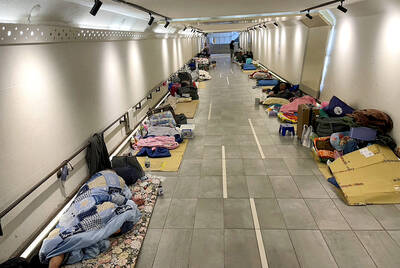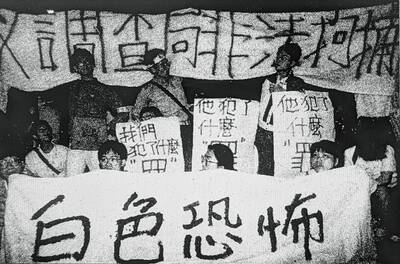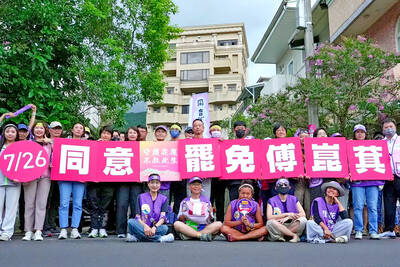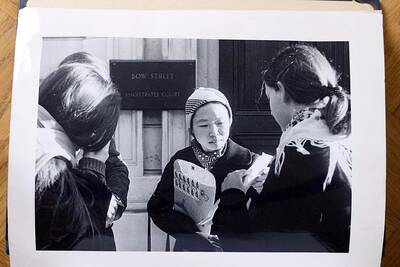There was little talk about art at a press conference held last week to promote this year’s Art Taipei. Rather than focus all their attention on the art fair, which begins on Friday, the assembled speakers competed in offering sympathy to the victims of Typhoon Morakot. The event reached a kind of denouement when Art Taipei CEO York Hsiao (蕭耀) presented an oversized check for NT$1 million to help victims of the disaster.
And the giving won’t stop there. Art Taipei organizers have pledged that the proceeds from tickets sold at the door will go to helping victims of the catastrophe.
“Last year [ticket sales] amounted to NT$2 million,” said Joanne Chen (陳韋晴), marketing director for Art Taipei. “We expect this number to increase to NT$3 million this year.”
Art Taipei will also hold a “charity bazaar” on Sept. 5 and Sept. 6 at a location that has yet to be determined. Chen said they expect galleries throughout Taiwan to collectively donate around 100 works of art. Proceeds from both events will go to The Red Cross Society of the Republic of China (中華民國紅十字會).
In its 16th year, Art Taipei is Taiwan’s
preeminent art fair. Forty-one galleries from Taiwan and 38 galleries from abroad will converge on the Taipei World Trade Center for five days where they will barter with potential buyers over paintings, sculpture, video and photography. This year’s theme is “Environment and Art” — fitting, perhaps, in light of accusations that lax enforcement of environmental regulations may have played a role in the Morakot disaster.
The fair also features a number of lectures by art professionals on topics ranging from the Asian art market to the future of contemporary art and investing in the current economic climate. Seating is limited to the first 100 applicants. For details of speakers and registration, go to www.art-taipei.com/2009aaeft.
Hsiao told the Taipei Times it is clear that the financial crisis still resonates with galleries both at home and abroad, with the number of participants dropping from 111 in 2008 to 78 this year. It is a reality, he said, that forced Art Taipei to focus on better galleries.
“We spent more time evaluating the galleries and we even rejected some. So the quality is better,” he said.
Hsiao, himself an artist and owner of Capital Art Gallery (首都藝術中心), added that although there are fewer participating galleries from Taiwan, there has been an increase in the number of galleries from Japan.
“Japanese galleries sold out all the work they brought with them last year. This news circulated among other galleries, which explains why there has been an increase in the number of Japanese galleries participating this year,” he said.
He added that no galleries have pulled out in the past few weeks — a sign that Typhoon Morakot isn’t having the kind of influence that the 921 Earthquake and SARS did.
Art Taipei was cancelled in 1999 because of the 921 Earthquake and stopped for three years after SARS struck in 2002.
Organizers expressed concern that the general public might avoid this year’s art fair.
“A lot of people might ... [be] doing charity work on the weekend for those in the south,” Chen said. But she was optimistic that donating ticket sales to the Red Cross may be an added incentive for art enthusiasts to check out the fair.
She said that professional buyers, on the other hand, wouldn’t be influenced.
“Although the economic crisis is affecting the art market, professional collectors are still buying work and looking for young artists. If they see some great work they absolutely must have it. That’s why international galleries like to come to Taiwan because there are many collectors. It’s totally different from investors who will avoid purchases when the economy is poor,” she said.
It’s a sentiment echoed by Yeh Ming-hsun (葉銘勳), owner of Main Trend Gallery (大趨勢畫廊), the gallery with the largest booth this year.
“Collectors usually have money in reserve. Although they lost money [in the global financial crisis], they still have some set aside for collecting,” said Yeh, who represents some of Taiwan’s top artists, including Chen Chieh-jen (陳界仁) and Wu Tien-chang (吳天章).
Of greater concern to Art Taipei, he said, is the increased profile of and competition from art fairs in Shanghai, Beijing, Seoul and Hong Kong.
“The art environment has changed over the past three years. Every country is competing to be the largest. Every country believes they are the largest and best,” he said.
“Many galleries from abroad will participate in the fairs in Shanghai and Hong Kong ... because they are more international in scope. Beijing and Taipei are more local — they are local galleries showing off local artists both from home and Southeast Asia. International galleries probably won’t participate in Taipei’s fair because it is too local,” he said.
Although Yeh is branching out to other countries — Main Trend participated in a Beijing art fair in April and will travel to Shanghai for another in early September — Art Taipei still remains for him the most important of its ilk because his gallery is in Taipei and it promotes Taiwanese artists.

From the last quarter of 2001, research shows that real housing prices nearly tripled (before a 2012 law to enforce housing price registration, researchers tracked a few large real estate firms to estimate housing price behavior). Incomes have not kept pace, though this has not yet led to defaults. Instead, an increasing chunk of household income goes to mortgage payments. This suggests that even if incomes grow, the mortgage squeeze will still make voters feel like their paychecks won’t stretch to cover expenses. The housing price rises in the last two decades are now driving higher rents. The rental market

July 21 to July 27 If the “Taiwan Independence Association” (TIA) incident had happened four years earlier, it probably wouldn’t have caused much of an uproar. But the arrest of four young suspected independence activists in the early hours of May 9, 1991, sparked outrage, with many denouncing it as a return to the White Terror — a time when anyone could be detained for suspected seditious activity. Not only had martial law been lifted in 1987, just days earlier on May 1, the government had abolished the Temporary Provisions Effective During the Period of National Mobilization for Suppression of the Communist

Hualien lawmaker Fu Kun-chi (傅崐萁) is the prime target of the recall campaigns. They want to bring him and everything he represents crashing down. This is an existential test for Fu and a critical symbolic test for the campaigners. It is also a crucial test for both the Chinese Nationalist Party (KMT) and a personal one for party Chairman Eric Chu (朱立倫). Why is Fu such a lightning rod? LOCAL LORD At the dawn of the 2020s, Fu, running as an independent candidate, beat incumbent Democratic Progressive Party (DPP) lawmaker Hsiao Bi-khim (蕭美琴) and a KMT candidate to return to the legislature representing

Fifty-five years ago, a .25-caliber Beretta fired in the revolving door of New York’s Plaza Hotel set Taiwan on an unexpected path to democracy. As Chinese military incursions intensify today, a new documentary, When the Spring Rain Falls (春雨424), revisits that 1970 assassination attempt on then-vice premier Chiang Ching-kuo (蔣經國). Director Sylvia Feng (馮賢賢) raises the question Taiwan faces under existential threat: “How do we safeguard our fragile democracy and precious freedom?” ASSASSINATION After its retreat to Taiwan in 1949, the Chinese Nationalist Party (KMT) regime under Chiang Kai-shek (蔣介石) imposed a ruthless military rule, crushing democratic aspirations and kidnapping dissidents from